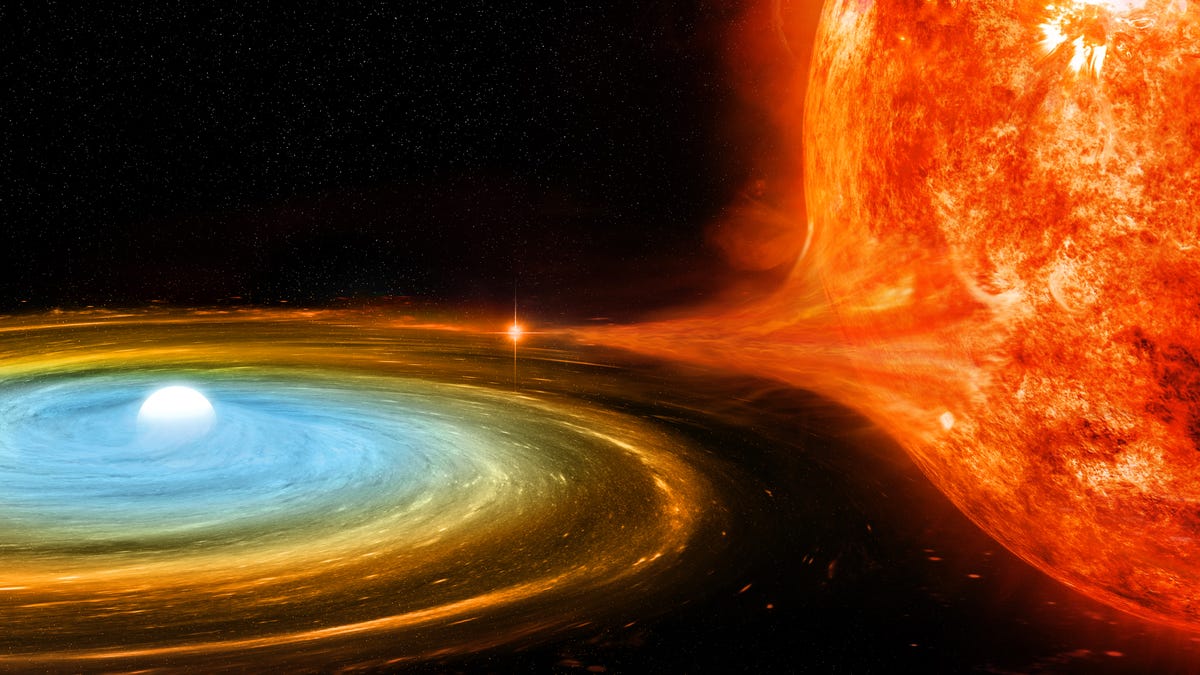Astronomers Discover 'Cataclysmic' Star Pair, Confirming Decades-Old Prediction
A "cataclysmic variable" system 3,000 light-years from Earth has the shortest orbital period yet discovered.

An artist's illustration of a cataclysmic variable system, where a white dwarf feeds on a sunlike star.
Searching through more than 1.2 billion stars across the cosmos with a powerful algorithm, astronomers have pinpointed a most unusual pairing: Two stars locked in a cosmic dance. That sounds benign enough, but this "cataclysmic variable" sees one star feasting on another, stripping away its outer layers like it's peeling an onion.
That's not science journalist hyperbole, by the way. Astronomers dub these systems cataclysmic variables, and it's an apt name. The term describes a pairing of a white dwarf, the dense remnant of a once-mighty star, and a secondary "normal" star, similar to the sun but, perhaps, with less mass. The tight orbit of the pairing sees the white dwarf suck up the stellar material from the larger star because of its extreme gravity.
The discovery of a new cataclysmic variable, published in the journal Nature on Wednesday, features a white dwarf 100 times smaller than the sun and a bigger star, about 10% the mass of the sun packed into a sphere the size of Jupiter. The pair, which reside around 3,000 light-years from the Earth, has been tagged ZTF J1813+4251.
It was discovered in images taken by the Zwicky Transient Facility, a wide-field survey that uses a telescope at the Palomar observatory in California and takes hundreds of images of the sky in sequence. The ZTF catalog allows astronomers to look for rapid changes in brightness from stars. That's how the researchers found this peculiar pair.
"This is a special system," said Kevin Burdge, an astrophysicist at MIT. He notes that it's "one of the most beautifully behaved cataclysmic variables known."
Burdge and his colleagues scoured the data from Zwicky to try to find lighthouses among the deep black of space. They wanted to see a characteristic blinking with regular timing – Burdge is typically looking for quick blinks, because they often signal a pair of stars orbiting each other rapidly. The team saw ZTF J1813+4251 flashing once every 51 minutes, as one of the stars passed in front of the other and dimmed its light. The timing of the flash corresponds to the shortest orbit for a cataclysmic variable discovered to date.
Observations with other telescopes, in Hawaii and Spain, and space-based telescopes then brought the pair into greater focus, allowing the researchers to measure the light it gave off more accurately. That led to a puzzle.
"One star looked like the sun," Burdge noted in a press release, "but the sun can't fit into an orbit shorter than eight hours."
The mass of the sun prevents it from having such a tight orbit. So why was this Jupiter-sized star doing just that? The explanation Burdge and the team has settled on is that the white dwarf has been gobbling up a good chunk of hydrogen from its partner star. That leaves behind a more dense core of helium, which helps stabilize the tight orbit. In short, the team is observing the pair in the middle of this process, when the white dwarf has stripped away much of the hydrogen. The stripping away leaves the white dwarf with an accretion disk, which surrounds the core like the rings of Saturn.
"This is a rare case where we caught one of these systems in the act of switching from hydrogen to helium accretion," Burdge said.
Amongst the 1.2 billion stars, the algorithm plucked out one of the most interesting cataclysmic variables we've yet discovered. The fortunate find helps shore up earlier theories about cataclysmic variables transitioning to ultrashort orbits, proposed almost four decades ago — now we know this does happen.
The team also ran simulations to determine the ultimate fate of ZTF J1813+4251. They predict that in around 70 million years, the pair will be orbiting each other even more briskly, making a full circuit once every 18 minutes.
Though we won't be around to see it, researchers will be able to study the cataclysmic variable in more detail once the Laser Interferometer Space Antenna, or LISA, is in orbit, sometime in the late 2030s. The series of satellites will be used to detect gravitational waves -- which these stellar dancing partners will produce

